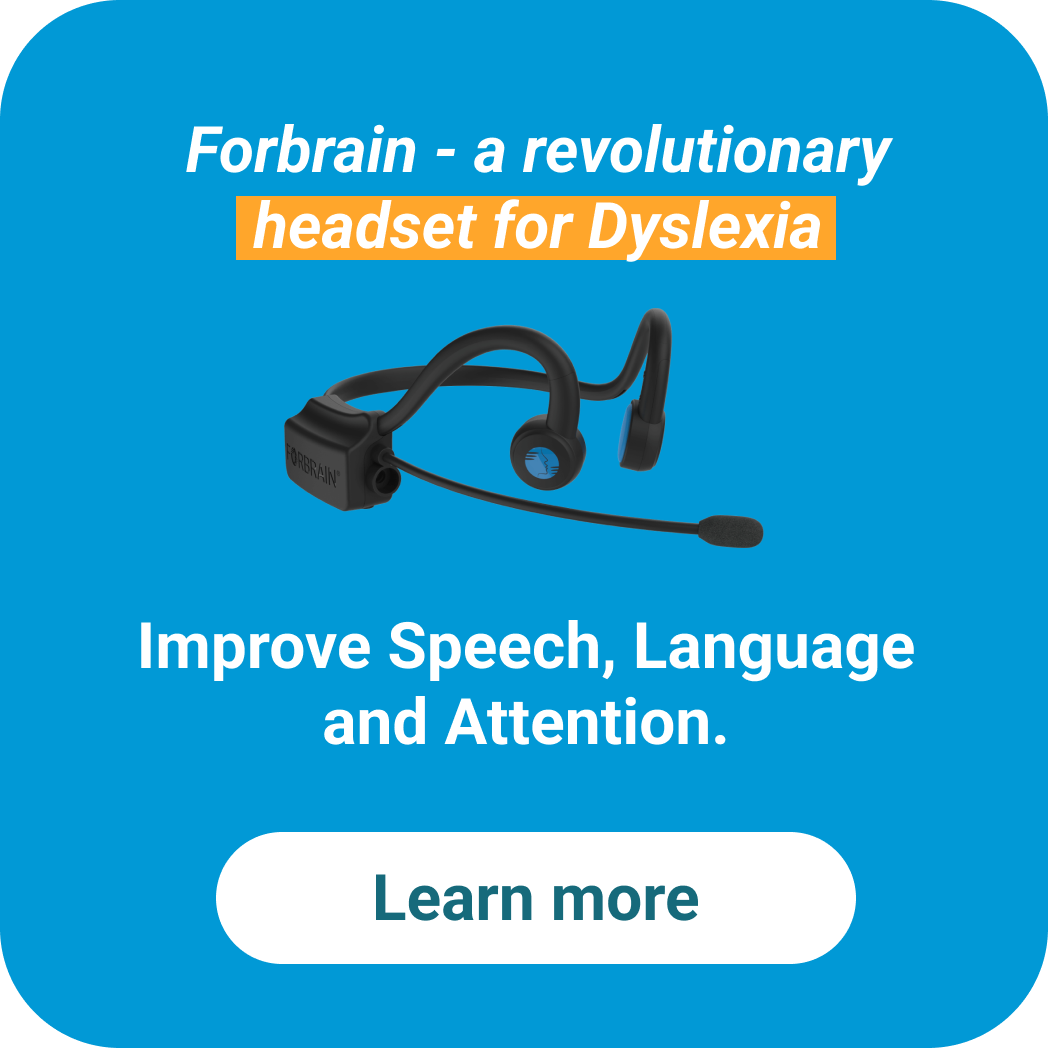Effective Evidence-Based Dyslexia Intervention Programs
 Amanda Unrau - October 04, 2023
Amanda Unrau - October 04, 2023 
Evidence Based Dyslexia Intervention Programs | What to Consider in Dyslexia Interventions | Using Forbrain
Targeted dyslexia intervention is an approach or method that helps individuals with dyslexia learn better. Dyslexia intervention is important for improving a child’s reading and writing skills. Children with dyslexia struggle with literacy. They are unable to gain literacy skills independently and require explicit direct instruction. This article will discuss evidence-based interventions that support individuals with dyslexia.
Evidence Based Dyslexia Intervention Programs
There are several evidence based dyslexia interventions. Below is an overview of each major intervention.
Orton-Gillingham Approach
The Orton-Gillingham approach is a direct structured way to teach literacy. It is especially helpful for those with dyslexia, or anyone who has difficulty naturally learning to read, write, and spell.
- What is it? A structured multisensory approach to teach reading, writing, and spelling.
- Instruction is individualized for each child and starts at their level before introducing new material specifically targeted to address their strengths and weaknesses.
- Phonics (the connection between letters and sounds) is explicitly taught. It teaches children to read at the word level.
- It is a highly structured approach that breaks down reading and spelling into simple concepts before building on these skills and then moving on to more complex skills over time.
- This multisensory approach includes sight, hearing, touch, and movement to help children make the connection between language and letters and words.
- An example learning sequence:
- Learn the connection between sounds and letters that represent those sounds.
- Recognize the sounds in words.
- Decode words independently.
Phonics-Based Reading Programs
Phonics based reading programs involve explicit teaching of phonemic awareness and phonics skills. This approach focuses on learning letter-sound correspondences. This intervention works well for students in primary grades. Difficulty with phonemic awareness indicates future reading difficulties, so this is an essential skill for reading success.
- What is it? Phonemic awareness and systematic phonics instruction.
- An understanding of phonics means understanding the correspondence between letters and sounds.
- Phonemic awareness is the ability to manipulate the sounds in speech. Phonemic awareness skills predict future reading success.
- Instruction is done systematically, progressing from the easiest to the most challenging skills.
- An example learning sequence:
- Children learn phonics skills (relationship between letters and their corresponding sounds).
- Use nonsense words to complete phonemic awareness tasks before using real words (syllable counting, phoneme counting, syllable and phoneme segmenting, blending, deletion, addition, and substitution).
- Use the above skills to decode and spell words phonetically.
Multisensory Learning Modalities
Multisensory teaching for dyslexia involves using a variety of pathways at the same time to improve learning and memory. These pathways include visual, auditory, and kinesthetic-tactile pathways. Individuals make connections between what they see, what they hear, and what they do in order to help them read and spell.
- What is it? The use of a variety of senses (tactile, kinesthetic, visual, auditory) to improve the learning and memory of written language.
- A variety of methods are utilized, including whole word memory, tracing, and phonetics.
- An example learning sequence:
- Children look in the mirror as they practice reading words or producing sounds.
- Children identify and say the sounds represented by the letters or letter patterns they see or write letters representing the sounds they hear. This helps them connect phonemes (sounds) to letters..
- Children imitate 5-7 words given by the instructor targeting a specific letter or pattern. They recognize the sound that is the same in all words.
- Children look at the written words and identify the target letter or letter pattern.
- Children trace, then copy, and then write the letter/pattern as they say the associated sound.
- Children read and spell words and sentences including the target patterns.
- Examples of ways to incorporate different senses:
- Visual: children look in the mirror as they practice reading words or producing sounds.
- Auditory: clap out the number of sounds or syllables in a word.
- Kinesthetic: children learn hand gestures.
Structured Literacy
Structured Literacy helps children read by learning to decode words. Instruction is explicit and follows a specific order. This approach is especially helpful for struggling readers, such as those with dyslexia.
- What is it? A reading approach that uses a direct systematic manner to teach children to decode words.
- It consists of several principles:
- Instruction must be systematic and cumulative. The material taught must follow the logical order or language.
- Instruction must be explicit. Since students will not understand these concepts on their own, there must be continuous interaction between a student and their teacher.
- Several important elements are taught:
- Phonology – the sound structure of spoken words
- Sound-Symbol Association – mapping phonemes to letters
- Syllable Instruction – learning the six basic syllable types in the English language
- Morphology – the smallest unit of meaning in language, such as root words, prefixes, and suffixes
- Syntax – the rules of the sequence of words in a sentence to express meaning
- Semantics – the meaning of words
- An example learning sequence:
- Teach and review letter names and letter sounds in isolation.
- Practice identifying letter names and sound in written words.
- Teach phonemic awareness, such as segmenting and blending phonemes, or adding, deleting, or substituting phonemes to or from words.
- Practice writing words using sound-letter mapping.
- Teach and practice sight words.
- Practice using these skills in reading practice.
What to Consider in Dyslexia Interventions
When implementing interventions, there are several factors to consider.
- Age. The child’s age can give you a general idea of where a child’s literacy skills should be and what they should be able to do. A younger child will need to start with more basic phonics and phonemic awareness skills, while an older child may be working on decoding words and sentences.
- Severity of dyslexia. Dyslexia can present on a range from mild to severe. A formal or informal assessment will help to determine how severe a child’s dyslexia is. A child with a more severe form of dyslexia will need to start with more basic skills than a child with mild dyslexia.
- Previous access to intervention. If a child previously received an intervention, consider the outcome of that intervention. Did the child respond to the previous intervention and make progress? If so, assess where their skills currently lie and pick up where the previous treatment left off. If no or limited progress was made, evaluate the child to determine a starting place and appropriate treatment approach based on their strengths and weaknesses.
- Individual needs. Any dyslexia treatment approach used should be individualized to meet each child’s needs. There is no ‘one size fits all’ method that can be implemented without being modified at all. While an orderly structure is needed, there should be constant informal evaluation of a child’s skills throughout the intervention so that adjustments can be made as needed.
- Learning preferences. Many children benefit from multiple modalities of learning, or may prefer one style of learning over another. For example, a student may learn best by making hand gestures as they practice saying sounds out loud, or singing a song to remember certain rules.
Dyslexia Programs: Our Expert Reviews
The following section delves into a variety of programs specifically designed to aid those with dyslexia. Our expert reviews aim to provide a comprehensive overview, helping parents, educators, and individuals make informed decisions about which intervention might best suit their needs or the needs of their loved ones.
LearningRx
A brain training program that uses intensive, one-on-one sessions to strengthen cognitive skills. It’s designed to improve memory, attention, processing speed, and problem-solving abilities through personalized training exercises.
Wilson Reading
A structured literacy program based on phonological-coding research and Orton-Gillingham principles. It’s designed for students with dyslexia and other reading difficulties, focusing on decoding, spelling, and comprehension through a multi-sensory approach.
Barton Reading & Spelling System
An Orton-Gillingham influenced program that is explicitly designed for tutoring students of all ages who have dyslexia or struggle with reading and spelling. The system is structured, sequential, and phonics-based, emphasizing multisensory learning.
Orton-Gillingham
A foundational approach used for the prevention and remediation of reading difficulties. This method integrates multisensory techniques to teach reading, spelling, and writing, emphasizing the direct instruction of phonics and the structure of the English language.
Neuralign
A relatively new intervention that focuses on aligning neurological pathways to improve learning and cognitive functions. It uses non-invasive techniques to address the root causes of learning difficulties, although specific methodologies and efficacy data may be less widely recognized than older programs.
Lindamood-Bell Learning Processes
Programs that target the underlying skills necessary for reading, comprehension, and math. These include sensory-cognitive instruction focusing on symbol imagery and concept imagery, aimed at improving language processing and comprehension.
Cellfield
A computer-based program designed to help individuals with dyslexia improve reading and comprehension skills. It combines visual and auditory stimulation to target the brain’s ability to process visual and auditory information simultaneously.
Fast ForWord
A series of computer-based reading programs that use adaptive learning technology to build the foundational language and literacy skills needed to read effectively. It focuses on improving brain processing efficiency through intensive, adaptive exercises.
Interactive Metronome
A program that aims to improve timing, attention, and coordination through a series of interactive exercises. It is designed to enhance cognitive, communicative, and motor skills by using rhythmic and timing-based exercises.
The Learning BreakThrough Program
A multi-sensory program designed to enhance cognitive performance through balance and sensory integration exercises. It aims to improve attention, memory, and processing speed, contributing to better learning and academic performance.
Using Forbrain to Help with Dyslexia
Forbrain is an auditory stimulation headset that can be incorporated into any of the above treatment approaches. Forbrain provides auditory feedback as the child wearing it hears their speech more amplified. This allows the child to hear their speech sounds louder and more clearly. This can help individuals with dyslexia as they read aloud or work on their phonemic awareness skills. In turn, this improves their engagement and motivation as they work in improving their literacy skills.
Final Words
Children with dyslexia have poor literacy skills, but there are ways to help. There are a variety of dyslexia intervention programs to choose from. When deciding on a treatment modality and how to implement it, consider the child’s age, severity of dyslexia, and learning preferences. Parents, educators, and healthcare professionals can choose the right dyslexia intervention program based on a child’s needs.
References
Al Otaiba, S., Gillespie Rouse, A., & Baker, K. (2018, October 24). Elementary Grade Intervention Approaches to Treat Specific Learning Disabilities, Including Dyslexia. Language, Speech, and Hearing Services in Schools, 49(4), 829-842. https://doi.org/10.1044/2018_LSHSS-DYSLC-18-0022
Hatch, Shelly. (Accessed 2023, October 27). Multisensory Teaching for Dyslexia. Learning Disabilities Association of Utah. https://www.ldau.org/multisensory-teaching-for-dyslexia
International Dyslexia Association. (Accessed 2023, October 27). Effective Reading Instruction. International Dyslexia Association. https://dyslexiaida.org/effective-reading-instruction/
Orton-Gillingham Academy. (Accessed 2023, October 25). What is the Orton-Gillingham Approach? Academy of Orton-Gillingham Practitioners and Educators. https://www.ortonacademy.org/resources/what-is-the-orton-gillingham-approach/
Rosen, Peg. (Accessed 2023, October 27). Orton-Gillingham: What You Need to Know. Reading Rockets. https://www.readingrockets.org/topics/dyslexia/articles/orton-gillingham-what-you-need-know





